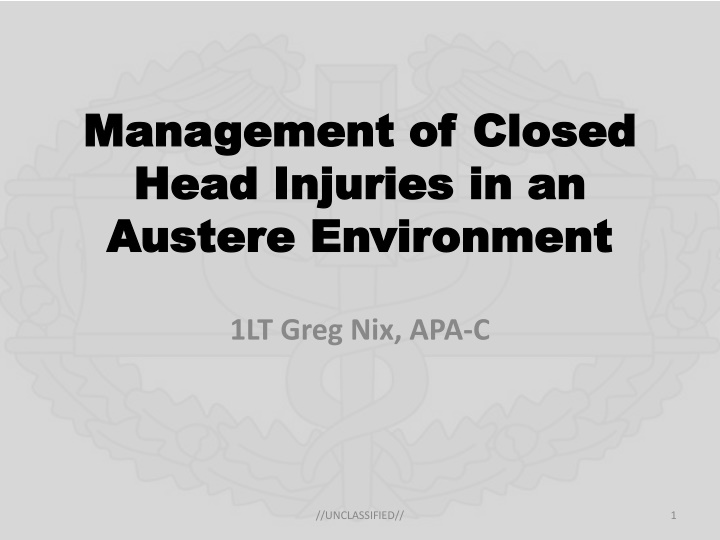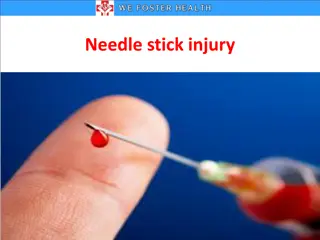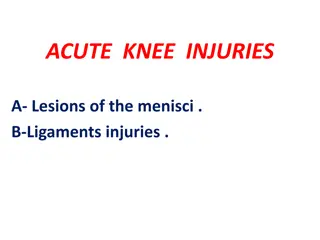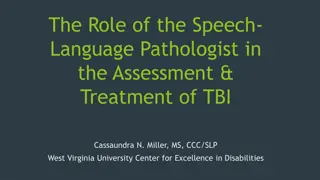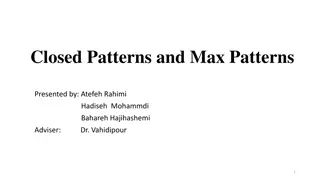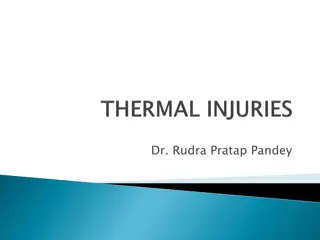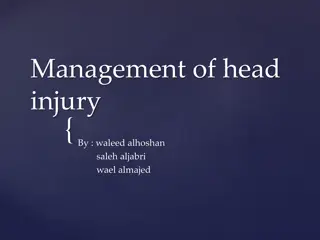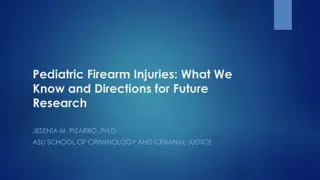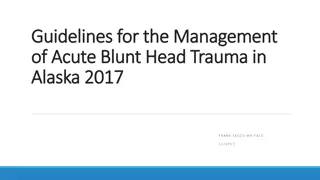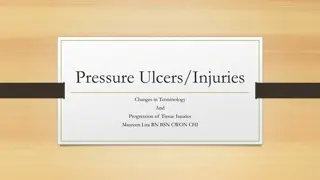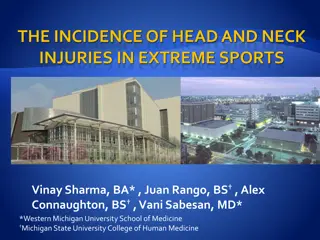Management of Closed Head Injuries in an Austere Environment Overview
Understanding the pathophysiology of brain injuries, including intracranial pressure changes and specific injuries such as traumatic brain injury (TBI), skull fractures, brain bleeds, and diffuse axonal injuries. It covers classifications, diagnosis, and treatment approaches for mild/concussion, moderate, and severe cases of TBI. The resource emphasizes the importance of monitoring, support, and evacuation suggestions in austere environments.
Download Presentation

Please find below an Image/Link to download the presentation.
The content on the website is provided AS IS for your information and personal use only. It may not be sold, licensed, or shared on other websites without obtaining consent from the author.If you encounter any issues during the download, it is possible that the publisher has removed the file from their server.
You are allowed to download the files provided on this website for personal or commercial use, subject to the condition that they are used lawfully. All files are the property of their respective owners.
The content on the website is provided AS IS for your information and personal use only. It may not be sold, licensed, or shared on other websites without obtaining consent from the author.
E N D
Presentation Transcript
Management of Closed Management of Closed Head Injuries in an Head Injuries in an Austere Environment Austere Environment 1LT Greg Nix, APA-C //UNCLASSIFIED// 1
Overview Overview Pathophysiology of an injured brain Pathophysiology of an injured brain Intracranial Pressure Intracranial Pressure TBI TBI Mild/Mod/Severe Mild/Mod/Severe Skull Skull Fx Fx Brain Bleeds Brain Bleeds Diffuse Axonal Inj. Diffuse Axonal Inj. Eval Eval & & Tx Tx Evacuation suggestions Evacuation suggestions //UNCLASSIFIED// 2
Pathophysiology of Brain Inj. Pathophysiology of Brain Inj. -Terms: CPP CPP CBF CBF Auto regulation Auto regulation MAP MAP Mean Arterial Pressure Mean Arterial Pressure ICP ICP Intracranial Pressure Intracranial Pressure Cerebral Perfusion Pressure Cerebral Perfusion Pressure Cerebral Blood Flow Cerebral Blood Flow //UNCLASSIFIED// 3
Intracranial Pressure Pressure changes Pressure changes Increase Increase Decrease Decrease Cushing's Reflex (triad) Cushing's Reflex (triad) HTN HTN Bradycardia Bradycardia Irregular Respirations Irregular Respirations //UNCLASSIFIED// 4
Specific Injuries TBI TBI Head trauma + Head trauma + AMS/LOC/PTA Mild (Concussion) Mild (Concussion) Mod Mod Severe Severe Skull Fx Skull Fx Brain Bleeds Brain Bleeds Diffuse Axonal Injuries Diffuse Axonal Injuries AMS/LOC/PTA //UNCLASSIFIED// 5
TBI TBI Mild/Concussion Mild/Concussion Classification: LOC < 30m, AMS < 1d, Classification: LOC < 30m, AMS < 1d, PTA < 1d PTA < 1d s s/ /sx sx: : HA/Vis HA/Vis disturb/N/V/Irritability disturb/N/V/Irritability GCS: 14 GCS: 14- -15 15 Dx: Dx: Physical exam & MACE Physical exam & MACE Tx: Tx: Supportive, brain rest, monitor Supportive, brain rest, monitor //UNCLASSIFIED// 6
TBI Moderate Moderate Classification: LOC Classification: LOC 30m >1d, >1d, PTA PTA 1 1- -7d s/ s/sx sx: : HA/Vis disturb/N/V/Irritability HA/Vis disturb/N/V/Irritability GCS: 9 GCS: 9- -13 13 Dx: Dx: AMS, PTA/RTA, MACE AMS, PTA/RTA, MACE Tx: Tx: +/ +/- - Airway, Supportive, +/ Airway, Supportive, +/- - Evac, Brain rest, non non- -operational operational 30m 24hrs 24hrs, , AMS AMS 7d Evac, Brain rest, //UNCLASSIFIED// 7
TBI Severe Severe Classification: LOC > Classification: LOC > 24hrs, 24hrs, 24hrs, PTA PTA > 7d > 7d s/ s/sx sx: : HA/Vis disturb/N/V/Irritability HA/Vis disturb/N/V/Irritability GCS: <9 GCS: <9 Dx: Dx: AMS, PTA/RTA, MACE AMS, PTA/RTA, MACE Tx: Tx: RSI Airway, ASAP Evac, Brain rest, non RSI Airway, ASAP Evac, Brain rest, non- - operational operational 24hrs, AMS AMS > > //UNCLASSIFIED// 8
Skull Fx Linear & Comminuted Linear & Comminuted s/sx: s/sx: May be obvious or occult May be obvious or occult Basilar Basilar Ascending/Descending point of many Ascending/Descending point of many vessels & nerves. vessels & nerves. s/sx: s/sx: Raccoon eyes, Battle signs, CSF leak, CN Raccoon eyes, Battle signs, CSF leak, CN def. def. Tx: Tx: Airway, Supportive, ASAP Evac Airway, Supportive, ASAP Evac //UNCLASSIFIED// 9
Brain Bleeds Cerebral Contusion Cerebral Contusion s/sx: s/sx: Exaggerated Concussion Exaggerated Concussion sx Intracerebral Hemorrhage Intracerebral Hemorrhage Focal Neuro def. often present Focal Neuro def. often present Pt may have residual effects Pt may have residual effects Dx: Dx: RTA/PTA without resolution RTA/PTA without resolution AMS AMS Tx: Tx: +/ +/- - Airway, Supportive, ASAP evac Airway, Supportive, ASAP evac sx //UNCLASSIFIED// 11
Brain Bleeds Subarachnoid Hemorrhage (SAH) Subarachnoid Hemorrhage (SAH) s/sx: s/sx: (often sudden/aneurysm) Profound photophobia, HA, N/V Profound photophobia, HA, N/V Textbook: Worst HA of life Textbook: Worst HA of life Dx: Dx: Abrupt onset of sx mod/severe TBI Abrupt onset of sx mod/severe TBI Tx: Tx: Control BP Control BP do not allow to exceed 140 do not allow to exceed 140 Syst. Syst. CCB & CT would be preferred but prob not CCB & CT would be preferred but prob not avail. avail. ( (Nimodipine Airway & Airway & Evac Evac! ! (often sudden/aneurysm) Nimodipine to stop vasospasm. Vasospasm stops flow to brain) to stop vasospasm. Vasospasm stops flow to brain) //UNCLASSIFIED// 12
Brain Bleeds Epidural Hematoma s/sx: s/sx: MOI: blast/fall, sports, MVA MOI: blast/fall, sports, MVA Probable skull Probable skull fx Middle Meningeal Artery! Middle Meningeal Artery! HA, AMS, Sz HA, AMS, Sz Dx: Dx: S/ S/sx sx, MOI, LOC with , MOI, LOC with lucid interval Tx: Tx: EVAC! Be prepared for RSI! EVAC! Be prepared for RSI! Control Control Sz Sz Epidural Hematoma fx lucid interval //UNCLASSIFIED// 13
Brain Bleeds Subdural Hematoma (SDH) Subdural Hematoma (SDH) s/sx: s/sx: LOC, AMS LOC, AMS Becomes sx within x14d Becomes sx within x14d Dx: Dx: Acceleration/Deceleration MOI Acceleration/Deceleration MOI Increase of sx over period of time Increase of sx over period of time Venous Hemorrhage Venous Hemorrhage Tx: Tx: Evac, CT Evac, CT Beware of death within x14d; usually 72hrs. Beware of death within x14d; usually 72hrs. //UNCLASSIFIED// 14
Diffuse Axonal Injury (DAI) s/ s/sx Sudden LOC/Unresponsive Sudden LOC/Unresponsive Shearing MOI Shearing MOI Dx: Dx: MOI, Prolonged unresponsiveness MOI, Prolonged unresponsiveness Tx: Tx: Respectful care, Irreversible. Respectful care, Irreversible. sx: : //UNCLASSIFIED// 15
Pt Eval/Exam Eval Eval Determine MOI, Level of Determine MOI, Level of consciousness consciousness PE & HEENT PE & HEENT MACE/AVPU/GCS MACE/AVPU/GCS Cognition Cognition Coordination Coordination CN II CN II- -XII exam XII exam Look for focal deficits Look for focal deficits //UNCLASSIFIED// 17
Pt Eval/Exam Ultrasound of Ocular nerve sheath Ultrasound of Ocular nerve sheath Place Place tegaderms tegaderms over Visualize the Optic nerve Visualize the Optic nerve Approx Approx x3mm from the globe, the x3mm from the globe, the nerve should be 5mm in width nerve should be 5mm in width 3x5 3x5 >5mm = increased ICP >5mm = increased ICP Watch if Watch if tx tx are efficacious!!!!! are efficacious!!!!! over pt s pt s eyes eyes //UNCLASSIFIED// 18
Interventions Packaging Packaging Trendelenburg 30 Trendelenburg 30- -45* Increases venous flow Increases venous flow non non- -constricting C constricting C- -spine protection Temp Temp Increased ICP pts tend to have elevated Increased ICP pts tend to have elevated temps temps Increased metabolic needs!!! Increased metabolic needs!!! Keep Keep pt pt cool cool Fluids Fluids Isotonic vs. Hypotonic Isotonic vs. Hypotonic 45* spine protection //UNCLASSIFIED// 19
Interventions Diuretics Diuretics Mannitol Mannitol Decreases ICP via Increasing Outflow Decreases ICP via Increasing Outflow and stimulating and stimulating Autoregulation 1g/kg 1g/kg Use Foley to measure Use Foley to measure pt s Replace fluids to avoid Replace fluids to avoid HoTN Best used for HTN pts with increased Best used for HTN pts with increased ICP ICP Autoregulation pt soutflow outflow HoTN (hypotension) (hypotension) //UNCLASSIFIED// 20
Interventions Diuretics Diuretics Hypertonic Saline 3% Hypertonic Saline 3% Increases CO2 Increases CO2 Increases Na+ gradient Increases Na+ gradient Decreases ICP by pulling fluid Decreases ICP by pulling fluid Admin 250mg over 10min Admin 250mg over 10min Best utilized in Best utilized in nml nml/ /HoTN HoTN pts pts //UNCLASSIFIED// 21
Interventions RSI: RSI: Succinylcholine Succinylcholine Etomidate Etomidate/Ketamine/ Steroid use Steroid use No longer used No longer used Especially not used with hemorrhage Especially not used with hemorrhage CO2 CO2 Watch End Watch End- -tidal carefully tidal carefully 33 33- -38 ideal 38 ideal /Ketamine/Propofol Propofol //UNCLASSIFIED// 22
Interventions Hyperventilation? Hyperventilation? No longer advocated due to ischemia No longer advocated due to ischemia Still acceptable with s/ Still acceptable with s/sx Life > perm. Adverse effects Life > perm. Adverse effects Pain Control Pain Control Fentanyl/Ketamine Fentanyl/Ketamine Helps prevent excess metabolic needs Helps prevent excess metabolic needs sx of Herniation. of Herniation. //UNCLASSIFIED// 23
To Evac, or Not to Evac? PECARN/New Orleans Trial PECARN/New Orleans Trial Normal mental Normal mental status No LOC No LOC No severe mechanism of No severe mechanism of injury No vomiting No vomiting No severe headache No severe headache No signs of basilar skull No signs of basilar skull fracture No Injuries No Injuries superior to clavicles superior to clavicles status injury fracture //UNCLASSIFIED// 24
Case Study Case Study GSW GSW Massive post. Neck bleed Massive post. Neck bleed Unresponsive Unresponsive Anisocoric Anisocoric No Resp. drive No Resp. drive Tachycardic Tachycardic face face //UNCLASSIFIED// 25
References Auerbach, Paul S., Howard J. Donner, and Eric A. Weiss. "Head Injury." Field Guide to Wilderness Medicine. 4th ed. St. Louis: Mosby, 1999. 139-44. Print. Lenhart, Martha K., Eric Savitsky, and Brian Eastridge. "Traumatic Brain Injury Management." Combat Casualty Care: Lessons Learned from OEF and OIF. N.p.: n.p., n.d. 33-378. Print. "Medicolegal Visuals." Medical Illustrator Medical Illustration Scientific Illustration. N.p., n.d. Web. 20 Feb. 2015. "Minor Head Trauma in Infants and Children: Evaluation." Minor Head Trauma in Infants and Children: Evaluation. UpToDate.com, 17 Oct. 2014. Web. 20 Feb. 2015. Papadakis, Maxine A., Stephen J. McPhee, and Michael W. Rabow. Current Medical Diagnosis & Treatment 2014. 2014 ed. N.p.: n.p., n.d. Print. "Pictures." TeachMeAnatomy. N.p., n.d. Web. 20 Feb. 2015. "Subarachnoid Hemorrhage vs. Subdural Hematoma." Galleryhip.com Images of Hemorrhage Types. N.p., n.d. Web. 20 Feb. 015. Swisher, Linda, and Kevin T. Patton. Study and Review Guide to Accompany Anatomy & Physiology, 7th Edition: Kevin T. Patton, Gary A. Thibodeau. 7th ed. St. Louis, MO: Mosby Elsevier, 2010. Print. Tintinalli, Judith E., Gabor D. Kelen, and J. Stephan. Stapczynski. "Ch. 255 HEAD INJURY." Emergency Medicine: A Comprehensive Study Guide. 6th ed. New York: McGraw-Hill, Medical Pub. Division, 2004. 1557-569. Print. "Welcome - EMCrit CME Site." EMCrit CME Site. N.p., n.d. Web. 21 Feb. 2015. //UNCLASSIFIED// 26
QUESTIONS? //UNCLASSIFIED// 27
